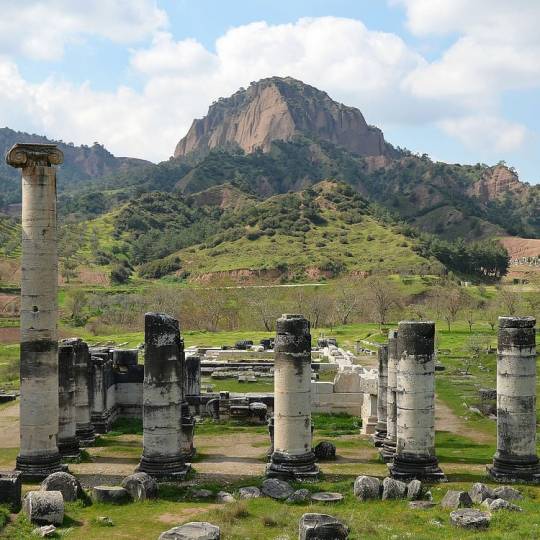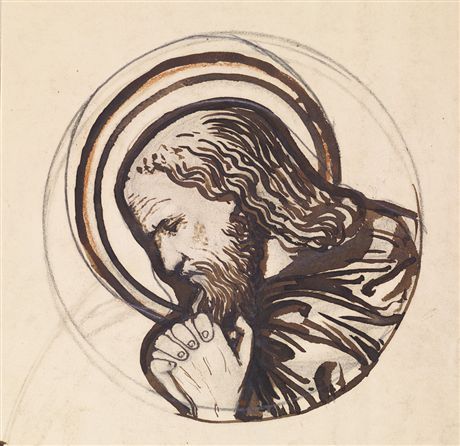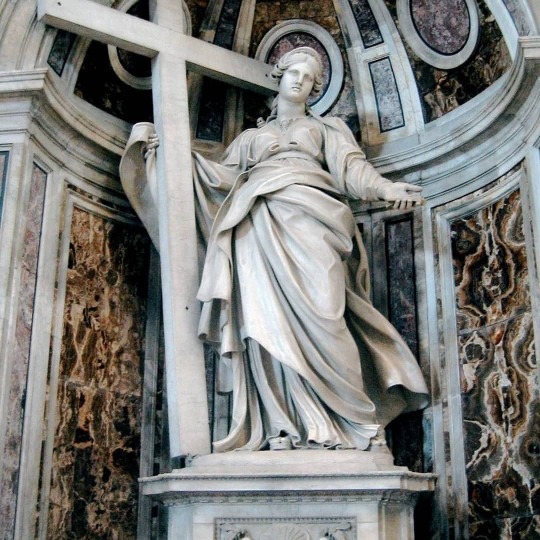#earlychristians
Quote
Reading the stories of many of the early Christians, I find that they were surprisingly like us. They were influenced by the surrounding culture in their thinking about finances, food, marriage and sexuality, patriotism and nationalism, and so on. More than anything, it is convicting how many of them, like our actor friend whose story we just learned, went to church on Sunday, but spent the rest of the week compartmentalizing their faith—just like so many Christians do today, often inadvertently, without meaning to. And it is convicting, furthermore, to see that at times, cultural sin did not flow from a rebellious heart, but simply resulted from a lack of better options. How well do we today support those in our own churches who seem deeply sinful, but perhaps are more similar to this actor convert than to someone rebelliously fighting against God?
Will the Real Cultural Christians Please Stand Up?
2 notes
·
View notes
Photo

Melito of Sardis and his Apology for Christianity
Melito of Sardis (d. c. 180 CE) was a bishop in the city of Sardis (near modern-day Sart, Turkey) who was regarded as one of the greatest Christian thinkers, writers, and apologists of his time. In the modern age, he is best known for his Apology for Christianity sent to emperor Marcus Aurelius regarding the persecution of Christians.
He is also, however, recognized for his lists of Old Testament works, commentary on scripture, and advocacy of celebrating Easter at the same time as the Jewish Passover in order to maintain the relationship between Judaism and Christianity. His work Peri Pascha (On the Pascha or On the Passover), only discovered in the past 100 years, focuses on the validity of the practice of those known as Quartodecimans who maintained that Easter needed to be celebrated on the 14th of the month Nisan (March-April) in keeping with the Jewish tradition of Passover and, because of this and other details in his works, it is believed he was a convert from Judaism.
Continue reading...
40 notes
·
View notes
Link
4 notes
·
View notes
Text
"The truth is like a lion; you don't have to defend it Let it loose; it will defend itself."
Augustine of Hippo, also known as Saint Augustine, was a theologian and philosopher of Berber origin and the bishop of Hippo Regius in Numidia, Roman North Africa.

Born: 13 November 354 AD, Thagaste
Died: 28 August 430 AD (age 75 years), Ruins of Hippo (Hippo Regius), Annaba, Algeria.
Early Life and Conversion: Augustine, born in 354 AD in North Africa (modern-day Algeria), led a life of worldly pursuits until his conversion to Christianity in 386. His spiritual journey is detailed in his famous autobiography, "Confessions."
Bishop of Hippo: Augustine served as the Bishop of Hippo (in present-day Annaba, Algeria) from 395 until his death in 430. During his episcopacy, he played a crucial role in defending orthodox Christian doctrine against various heresies.
Major Works: Augustine's writings have had a profound impact on Christian theology. His notable works include "Confessions," an introspective autobiographical work, and "The City of God," a monumental treatise on theology, philosophy, and the destiny of humanity.
Doctrine of Original Sin: Augustine developed the influential theological concept of Original Sin, which posits that humanity inherits a sinful nature from the fall of Adam and Eve. This idea has had a lasting impact on Christian theology and soteriology.
Influence on Western Christianity: Augustine's teachings have left an indelible mark on Western Christianity. His views on grace, predestination, and the relationship between faith and reason have shaped theological discussions for centuries, influencing both Catholic and Protestant traditions.
#AugustineOfHippo#ChurchFather#Theologian#Philosopher#Bishop#Confessions#CityOfGod#EarlyChristianity#AureliusAugustinus#CatholicSaint#ChristianDoctrine#OriginalSin#Neoplatonism#FaithAndReason#MoralPhilosophy#Patristics#DoctorOfTheChurch#WesternChristianity#ConversionStory#TheologicalInfluence#philosophy#deep thinking#quoteoftheday#today on tumblr#deep thoughts
1 note
·
View note
Text
🔮✨ Welcome back, fellow knowledge seekers, to another captivating chapter of The Radical Scholar’s exploration into ancient texts and hidden wisdom. Today, we embark on a transformative journey, peering into the depths of the enigmatic Book of Enoch. Within its sacred pages lie profound revelations and timeless wisdom. Join us as we unveil 10 fascinating facts that shed light on its ancient origins, heavenly journeys, apocalyptic themes, and the profound influence it has wielded on early Christianity and contemporary spirituality. 📚🌌
#BookOfEnoch#AncientWisdom#HeavenlyJourneys#ApocalypticVisions#Enoch#WatchersAndNephilim#EarlyChristianity#Scholarship#MysticalTexts#HiddenWisdom#DivineMysteries
1 note
·
View note
Photo

The character of Miranda is frustrated. Tradition demands one thing and a higher power orders another. She is isolating allies. Women are not taken seriously. Get yourself wrapped up in the war preparations. Nobody wants it, yet isn't expecting the depths. It doesn't seem to end... #MilitaryCampaign #WorldWar #LordGeneral #MeetingOfTheGenerals #MilitaryTradition #MilitaryParade #GoodSoldiers #OldSoldiersNeverDie #TheyJustFadeAway #Klenard #FantasySeries #MotherChurch #WarOnIdeas #EarlyChristianity #WarOnCommunism #ActionAdventure #IndieAuthor #NewBritain https://www.instagram.com/p/CoFkJEqrOYc/?igshid=NGJjMDIxMWI=
#militarycampaign#worldwar#lordgeneral#meetingofthegenerals#militarytradition#militaryparade#goodsoldiers#oldsoldiersneverdie#theyjustfadeaway#klenard#fantasyseries#motherchurch#waronideas#earlychristianity#waroncommunism#actionadventure#indieauthor#newbritain
0 notes
Photo

On Sunday I took a trip out of Tbilisi to two extraordinary 3rd/4th century churches up in the Caucusus mountains. Georgia seems to have done Christian churches even back in the days when Christianity was still a new idea. These old buildings are most certainly the real thing - I wondered if churches ever got more beautiful or impressive. #Jvari #svestitskhovelicathedral #georgia🇬🇪 #tbilisi❤️ #christianchurches #earlychristianity (at Svetitskhoveli Cathedral) https://www.instagram.com/p/Ciu0l8RKBDZ/?igshid=NGJjMDIxMWI=
0 notes
Text
I was asked to carve a Pagan - Christian relief for an event, who knows which film I took the design from? #pagan #christian #scandinavian #early #pan #christ #mary #ship #earlychristianity #panel #relief #handcarved #craftsmanship
0 notes
Video
We all need discipleship to grow... #paulwasher #makedisciples #makingdisciples #spiritualgrowth #dontgiveupmeetingtogether #youth #newchristians #earlychristians https://www.instagram.com/p/B4QB04Cl-ki/?igshid=ec7ghlwychtd
#paulwasher#makedisciples#makingdisciples#spiritualgrowth#dontgiveupmeetingtogether#youth#newchristians#earlychristians
2 notes
·
View notes
Photo

(ES) Adelanto de las portadas de los próximos números de Arqueología e Historia @despertaferro_ediciones con mis ilustraciones en las RRSS de la editorial. A la espera que superemos este desastre de #coronavirus para volver a la normalidad. (EN) Preview of the covers of the next issues of Archaeology and History Desperta Ferro with my illustrations. Waiting for us to overcome this #coronavirus disaster to get back to normal. #ru_mor #desvanrumor #despertaferro #magazine #illustration #cover #archaeology #history #cid #earlychristians #cidstimes #medieval https://www.instagram.com/p/B-0FzNlo8OL/?igshid=1qatzc4fcbcwx
#coronavirus#ru_mor#desvanrumor#despertaferro#magazine#illustration#cover#archaeology#history#cid#earlychristians#cidstimes#medieval
0 notes
Photo

St Paul, 1862, Edward Burne-Jones
Medium: indianink,paper,chalk,pencil
16 notes
·
View notes
Quote
Throughout the history of the church, Christians have keenly desired to believe that the New Testament affirms the kind of people we are, rather than—as is actually the case—the kind of people we are not, and really would not want to be. The first, perhaps most crucial thing to understand about the earliest generations of Christians is that they were a company of extremists, radical in their rejection of the values and priorities of society not only at its most degenerate, but often at its most reasonable and decent. They were rabble. They lightly cast off all their prior loyalties and attachments: religion, empire, nation, tribe, even family. In fact, far from teaching “family values,” Christ was remarkably dismissive of the family. And decent civic order, like social respectability, was apparently of no importance to him. Not only did he not promise his followers worldly success (even success in making things better for others); he told them to hope for a Kingdom not of this world, and promised them that in this world they would win only rejection, persecution, tribulation, and failure. Yet he instructed them also to take no thought for the morrow.
David Bentley Hart
10 notes
·
View notes
Photo

Flavius Josephus
Titus Flavius Josephus (36-100 CE), was born Yosef ben Matityahu and became a 1st-century CE Jewish historian. He was a member of a priestly household in Jerusalem through his father’s side (the house and order of Jehoiarib), and his mother was of royal descent (Hasmonean). He was educated in Jerusalem and most likely shared ideology and sympathy with the party of the Pharisees.
Continue reading...
41 notes
·
View notes
Photo

Reposted from @stpaulse Blessed Memorial of St. Helena of Constantinople! . St. Helena was born circa 246 in what is now northern Turkey and married Roman general Constantius Chlorus circa 270. They had a son shortly thereafter and Constantius was made Caesar, or vice emperor, in 293. Constantius soon divorced Helena to marry the emperor's stepdaughter. . Her son, Constantine, became emperor in 312 and he appointed his mother as Augusta, or empress. She converted to Christianity and practiced great charity including construction of churches in Rome and the Holy Land. She established the Church of the Nativity, Bethlehem, and the Church on the Mount of Olives, sites of Christ's birth and ascension, respectively. Helena's faith led to conversion of her son and, ultimately, to the Edict of Milan which provided legal protection for Christians. . Helena went on a pilgrimage to the Holy Land to find relics from the time of Christ. She demolished a pagan temple that Emperor Hadrian built on Calvary and found three crosses there. Helena and Bishop Macarius brought a woman, near death, to the site. The woman touched the first two crosses and had no change in her health. The woman then touched the third cross and was instantly healed. Helena declared this to be the True Cross of Jesus Christ and the Church of the Holy Sepulchre was built there. (Source: "The Catholic Encyclopedia") . St. Helena of Constantinople, pray for us! . . . #sharethefaith #saintoftheday #helena #sthelena #sainthelena #constantine #constantinople #femalesaints #truecrossrelic #truecross #motheroftheking #healing #miraclehealing #findingofthetruecross #findingofthecross #catholic #christian #catholicsaint #churchhistory #earlychristianity #vatican #vaticancity #catholicimagery #augusta #queen #catholicroyalty #christianroyalty - #kofc12240 (at Rome, Italy) https://www.instagram.com/p/CEB7IX5Dg7J/?igshid=zwd1sqbccyk6
#sharethefaith#saintoftheday#helena#sthelena#sainthelena#constantine#constantinople#femalesaints#truecrossrelic#truecross#motheroftheking#healing#miraclehealing#findingofthetruecross#findingofthecross#catholic#christian#catholicsaint#churchhistory#earlychristianity#vatican#vaticancity#catholicimagery#augusta#queen#catholicroyalty#christianroyalty#kofc12240
1 note
·
View note
Text
The Gnostic Gospels
The Gnostic Gospels are a collection of ancient texts that were discovered in the mid-20th century, shedding light on the beliefs and practices of early Christian groups known as Gnostics. These texts are not part of the traditional New Testament canon found in mainstream Christianity but are considered important for understanding the diversity of early Christian thought.
The word "Gnostic" comes from the Greek word "gnosis," meaning "knowledge" or "insight." Gnosticism was a complex and diverse movement that emerged in the early centuries of Christianity and was influenced by various religious, philosophical, and mystical traditions of the time.
Key Characteristics of Gnosticism:
Esoteric Knowledge: Gnostics believed in the existence of secret knowledge or insights (gnosis) that could lead to salvation and a deeper understanding of the divine realm.
Dualism: Gnosticism often posited a dualistic view of the world, dividing reality into two realms: the material, imperfect world created by a lesser or ignorant deity (the Demiurge), and the spiritual, perfect realm of the supreme divine being.
Salvation through Knowledge: Gnostics taught that salvation involved liberating the divine spark trapped within the material world, and this could be achieved through the acquisition of secret knowledge.
Rejection of the Material World: Gnostics generally regarded the material world as inferior and often associated it with evil or ignorance.
Christology: Gnostic views of Jesus Christ varied, but many Gnostic texts presented Jesus as a divine being who imparted secret knowledge to his followers, helping them escape the material world and attain salvation.
The Nag Hammadi Library: The most significant collection of Gnostic texts was found in 1945 near the town of Nag Hammadi in Egypt. This discovery led to the unearthing of several ancient manuscripts, including the Gospel of Thomas, the Gospel of Mary, the Gospel of Philip, and many others. These texts provide valuable insights into the diverse beliefs and practices of early Gnostic communities.
Importance and Controversy: The Gnostic Gospels have sparked significant scholarly interest and debate. Some scholars believe that elements of Gnostic thought influenced early Christianity, and the conflicts between orthodox Christian beliefs and Gnostic teachings may have contributed to the development of Christian orthodoxy. Others argue that Gnosticism should be seen as a distinct religious movement separate from mainstream Christianity.
It's important to note that the Gnostic Gospels do not represent a unified or coherent system of beliefs but rather a diverse range of ideas and perspectives. As with any historical and religious texts, interpreting the Gnostic Gospels requires careful analysis and consideration of their historical context and the beliefs of the communities that produced and preserved them.
#GnosticGospels#EarlyChristianity#NagHammadiLibrary#Gnosticism#AncientTexts#ChristianHistory#GospelofThomas#GospelofMary#GospelofPhilip#EsotericKnowledge#EarlyChristianCommunities#DiversityofBeliefs#ReligiousScholarship#HistoricalContext#ReligiousTexts#ChristianOrthodoxy#DiverseBeliefs#ScholarlyDebate#ReligiousMovements#SpiritualBeliefs#today on tumblr#deep thoughts#deep thinking
0 notes
Text

The Meal of the Bull and the Supper of the Lamb:
Exploring the Similarities and Differences Between the Mithraic Mysteries and the Christian Eucharist
Introduction
“Which the wicked devils have imitated in the mysteries of Mithras, commanding the same thing to be done” (www.logoslibrary.org). These are the words penned by Justin Martyr, a Christian saint who lived between 100-165 CE. Martyr, a Christian apologist, noted the similarity between the Eucharist and the Mithraic Mysteries and used these words to write them off, so to speak. The Devil is in the details here, subverting the central event in the life of the Church by replacing it with a demon instead of the glorified and risen Christ.
While Martyr’s language is pointed, to say the least, he is on to something. The nature between the two rites is extremely similar. Both took place in the context of a communal meal, both involved bread and wine, and both connected the meal with sacrifice. What’s more, the two religions spring out of the First-Century Mediterranean world; more specifically, both are rooted within a Roman context.
Ultimately, though, the similarities stop there. The Christian Church did not copy the rites of Mithraism, nor did the cult of Mithras steal the Church’s liturgy in order to compete with the Church for proselytes. The central rites of Mithraism and Christianity, despite similar in form and function, differ in content, purpose, and propitiation and therefore cannot be equated.
The Mithraic Mysteries
The Mithraic Mysteries can be found in a document called the Great Magical Papyrus of Paris. It is important to note that this document comes from the Fourth Century CE, but the liturgy it contains is possibly traced back to the Second Century CE (Meyer, 182). The document more than likely comes from Egypt, a region that hardly had any Mithraic activity (Alvar, 532).
After the worshippers gathered in their Mithraea, an underground sanctuary that is rectangular in shape and is centered around a pedestal-shaped altar located in an apse in the back of the sanctuary, the ceremony begins.
The celebrant opens with a litany-like prayer that ascends the soul out of the body and into the spiritual plane, and while the celebrant is listing the deities being invoked, the communicants would draw onomatopoeic phrases from their mouths, such as hisses or hums or stringing the Greek vowels together (Meyer, 183). What is interesting about the opening is that it is summoning the four elements—wind (spirit is what Meyer has, but pneuma can be translated as breath or air), fire, water, and earth. After invoking the four elements, the celebrant asks the elements to be “[given] over to immortal birth and . . . undying nature, so that after the present need which is pressing [the celebrant] sorely, [he] may gaze upon the immortal spirit, with the immortal water, with the most steadfast air, that [he] may be born again in thought, that the sacred spirit may breathe in [him], that [he] may wonder at the sacred fire, that [the celebrant] may gaze upon the unfathomable, awesome water of the dawn, and the vivifying and encircling ether may hear [him]” (Meyer, 183-84).
After invoking the primordial elements, the celebrant summons what are called the Lower Powers of the Air and, at this point, will be completely cut off from reality. Now the celebrant slips into an ecstatic state, “[not] hear[ing anything from] either humanity or of any other living thing” (Meyer, 184). These beings that are summoned during this trance are lower deities or angelic beings that have a more direct role in human affairs. What is strange is that the text has these beings “rushing” towards the congregation, but after the celebrant says the incantation of silence and asks for protection from the “symbol of the living, incorruptible god”, the beings stop and go about their business (Meyer, 185).
At that moment the sun disk opens and Aion, the son of the virgin Kore and a Hellenistic god of time, appears. What is fascinating about this figure is that the responsory of the congregation uses a version of the Tetragrammaton, or the unspeakable name of the Hebrew God: Iao. The language suggests that Aion is, in fact, Yahweh, and it appears that Mithraism held Yahweh within its belief system. What is interesting is Yahweh is not the highest deity in the pantheon (Meyer, 186).
While Aion is present, the celebrant invokes “the immortal names” of the “seven gods of the universe” in order to pass over from the realm of fire to the doorway of the realm of the gods. The celebrant enters, greets the god Helios and the seven goddesses of fate, and bids the seven pole gods to sit. And then, at last, the celebrant stands before the god Mithras (Meyer, 186-188).
Mithras is described as a “god immensely great, with a bright appearance, youthful, golden-haired, wearing a white tunic, a golden crown, and trousers, and holding in his shoulder a golden right shoulder of a young bull” (Meyer, 189). The last descriptor is particularly important, because the Mithraic Mysteries invite the participants to partake of Mithras’ sacrifice of the bull. It is the central act of the entire religion, for when the congregants partake of the sacred meal, they are eating the sacrificed flesh and drinking the sacrificed blood of the bull (Beck, 27-28).
The celebrant then invites Mithras to inhabit his soul, and after uttering a revelation from Mithras, the celebrant initiates the sacred meal of wine and cake made from lotus pulp and honey (Meyer, 190).
The Christian Eucharist
The Christian Eucharist, like the Mithraic Mysteries, was historically connected to an actual meal. The author of Jude, while critiquing antinomians, writes, “These are blemishes on your love-feasts, while they feast with you without fear, feeding themselves” (Jude 1:12, New Revised Standard Version). And, like the Mithraic Mysteries, the Eucharist involves bread and wine.
However, the liturgy is vastly different than that of the Mithraic Mysteries. The Mithraic Mysteries involve spiritual ecstasy and transcending physicality in order to become spiritually united with Mithras. The Christian Eucharist is nothing like that. In the New Testament, the Apostle Paul writes, “For I received from the Lord what I also handed on to you, that the Lord Jesus on the night when he was betrayed took a loaf of bread, and when he had given thanks, he broke it and said, ‘This is my body that is for you. Do this in remembrance of me.’ In the same way he took the cup also, after supper, saying, ‘This cup is the new covenant in my blood. Do this, as often as you drink it, in rememberence of me.’ For as often as you eat this bread and drink the cup, you proclaim the Lord’s death until he comes” (1 Corinthians 11:23-26, New Revised Standard Version). The Eucharist does not involve any sort of physical transcendence. Rather, it celebrates physicality; in some circumstance—be it corporeally, spiritually, or memorially—Jesus becomes present. There is no disconnecting from the body or from reality in the Eucharist.
Also, examining the 1 Corinthians text, the focus between the two rites is vastly different. The Mithraic Mysteries are focused on the slaughter of the bull by the hands of Mithras. The Eucharist is focused on an entirely different sacrifice, that of Jesus himself. And the Eucharist conveys a different kind of sacrifice than that of the Mithraic Mysteries; while the Mysteries are concerned with the slaughter of a bull for sport, the Eucharist presents Christ as being given over to death for sin.
The person to whom the oblation is made differs between Mithraism and Christianity. In the Mithraic Mysteries, Iao—Yahweh—is the gatekeeper for the doorway into the realm of the gods. Within the Christian context, Yahweh the Father is who the perfect and complete sacrifice of Christ the Son is offered. It is God doing the sacrificing, and it is God who the sacrifice is pleasing. The Eucharist is simply the participation—be it corporeally, spiritually, or metaphorically—of Christ’s once and for all sacrifice.
The concept of time ought to be explored. Between the two liturgies, the perpetuation of the rite differs. Eschatologically speaking, the Mithraic Mysteries continue without any restraint in time. For the Christian Eucharist, the Supper is only a temporary rite until Jesus returns. “For as often as you eat this bread and drink the cup, you proclaim the Lord’s death until he comes,” Paul writes to the church in Corinth. The celebration of the Eucharist stops once the eschaton—the end of time—is fully realized.
The social contexts in which these liturgies would be celebrated is important note. The Mithraic Mysteries would have been celebrated on the behalf of and for the Roman upper class. It was a cult that had a massive following among the Roman soldiers and noblemen. Christianity, on the other hand, appealed to the working class and to the poor; early Christians were known for offering material and financial support to the outcasts of society, as well as allowed women to partake of the central rites of the faith. The cult of Mithras was exclusionary; only men were allowed to worship Mithras.
Conclusion
The Mithraic Mysteries and the Christian Eucharist do have things in common. Both are connected to Yahweh, involve some sort of propitiation, and feast upon flesh and blood. But the two liturgical meals cannot be seen as plagiarisms of each other. The theologies that both present are too distinct, and the audiences are too vastly different.
#mithraism#biblical studies#new testament#history#first-century#apostle paul#liturgy#eucharist#yahweh#jesuschrist#earlychristianity
2 notes
·
View notes